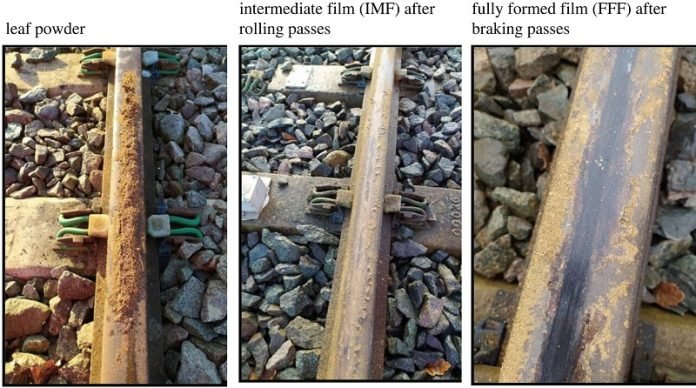
Every autumn and winter, train tracks become surprisingly slippery, leading to delays that frustrate passengers and cost the rail industry millions.
But what causes this slippery menace?
Engineers at the University of Sheffield have dug into the issue and discovered the sneaky culprits: leaves and the chemicals they release.
Dr. Joe Lanigan and his team from the university’s Department of Mechanical Engineering have been on a detective mission to find out why leaves make train tracks so slippery.
It turns out, when leaves get squished by train wheels against the rails, they don’t just stick; they transform into a super slippery layer, much like the dreaded black ice on roads.
This leafy layer is a big problem because it makes it hard for trains to start moving and to stop.
Network Rail, which looks after the UK’s train tracks, calls it the “black ice of the railway.” It’s a big deal because it can cause a lot of delays and safety issues.
The researchers have been looking closely at what happens when these leaves meet the train tracks. They’ve found out that certain chemicals in the leaves, like polyphenols (which are also in things we enjoy like wine and tea), are major players in creating this slippery film.
When leaves are crushed, these chemicals react under the pressure and heat from the train wheels, sticking to the metal and creating a slick surface.
Their study, published in a fancy science journal, shows that these chemicals form a thin but tough film that makes the tracks slippery.
This is a breakthrough because it gives clues on how to solve the problem. If we know what makes the tracks slippery, we can figure out how to clean them up more effectively.
The team suggests that targeting these specific chemicals might be the way to go. They’re thinking about using special cleaning agents that can break down these tricky chemicals or even using enzymes – a kind of natural cleaner – to munch away the slippery layer.
This could be a more environmentally friendly solution than the current methods, which can be pretty harsh, like chopping down trees or using a lot of energy to clean the tracks.
Dr. Lanigan shared that they’re trying to understand how leaves go from being harmless bits of nature to causing train chaos. Their friends at the University of York are helping out by looking at the problem from a biological angle, while the Sheffield team focuses on the slippery effects.
Looking ahead, the goal is to come up with smart ways to keep the tracks clear without harming the environment. They’re even testing out enzymes that could eat up the leafy layer without needing to cut down trees or use lots of energy.
This research is just the beginning. The team is excited about the possibilities of using science to keep trains running smoothly and on time, making travel better for everyone.
The journey to beat the slippery leaf problem is on track, and with these new insights, we’re getting closer to solving one of the rail industry’s slipperiest issues.
The study was published in the journal Proceedings of the Royal Society A: Mathematical, Physical and Engineering Sciences.



